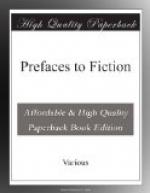Letters, published at Newcastle in 1746. (The Dublin
edition of 1753 I have not seen.) Though d’Argens’s
purpose in Letter 35 may have been to advertise his
own novel, what he had to say is interesting.
Like many others, he could scoff at the heroic romances
and yet borrow and quietly modify the doctrines of
Ibrahim and
Clelie. He proposed
a still more “advanced”
vraisemblance
and
decorum—psychological analysis
tinged with cynicism rather than idealism; gallantry
but against the background sometimes of the modern
city; a plainer style; and only such matters as seemed
to this student of Descartes and Locke to be entirely
reasonable. Fielding’s chapter in
Tom
Jones (IX, i) “Of Those Who Lawfully May,
and of Those Who May Not, Write Such Histories as This”
could be taken as an indication that he knew not only
what
Mlle. de Scudery thought were the accomplishments
of the romancer but that he had read d’Argens’s
words on that subject too. Both d’Argens
and Fielding believed that in addition to “Genius,
Wit, and Learning” the novelist must have a
knowledge of the world and of all degrees of men,
distinguishing the style of high people from that of
low. They agreed that a writer must have felt
a passion before he could paint it successfully.
Much more goes into the making of a novel, they sarcastically
pointed out, than pens, ink, and quires of paper.
D’Argens, like Fielding, relished reflective
passages and could approve, more readily than Mrs.
Manley, of “an Historian that amuses himself
by Moralizing or Describing.” D’Argens’s
list of the features to be found in good history and
good fiction shows him to be a thoroughgoing rationalist
and separates his ideal from that of young readers,
who, according to the preface to
The Adventures
of Theagenes and Chariclia (1717), wish to hear
of “Flame and Spirit in an Author, of fine Harangues,
just Characters, moving Scenes, delicacy of Contrivance,
surprising turns of action ... indeed the choicest
Beauties of a
Romance.”
The two novels that d’Argens recommended had
different fortunes in England. D’Argens’s
book, Memoires du Marquis de Mirmon, ou Le Solitaire
Philosophe (Amsterdam, 1736) was never translated
into English and apparently was not much read.
But Claude Prosper Jolyot de Crebillon, the younger,
was extolled by Thomas Gray and Horace Walpole, quoted
by Sarah Fielding,[9] and had the honor, if one can
trust Walpole, of an offer of keeping from Lady Mary
Wortley Montagu. His Egaremens du Coeur et
de l’Esprit (1736-38) was translated in
1751[10] and is the novel which Yorick helped the
fille de chambre slide into her pocket.
Crebillon was damned, however, in The World
(No. 19, May 10, 1753) in an essay that, oddly enough,
reminds one of d’Argens’s Letter 35.
The work referred to in the third footnote on page
258 is Le Chevalier des Essars et la Comtesse de
Berci (1735) by Ignace-Vincent Guillot de La Chassagne.
The last footnote on that page refers to G.H.
Bougeant’s satire, Voyage Merveilleux du
Prince Fan-Feredin dans la Romancie (1735).




